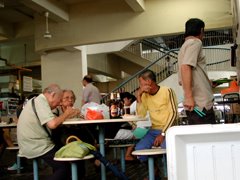Today is the 9th day of the Lunar New Year. It is the birthday of the Jade Emperor, more popularly known to the Hokkien (Fujian) people as Ti Kong (Tian Gong in Mandarin). It is probably the single most important day for the Hokkien Taoists. As in the Chinese way of counting time, the first hour of the new day starts on the night before (in modern clock time) from 11pm. And so, the Hokkien would start their prayers from last night at 11pm, and well, depending on the throwing of the pua-puay (sheng-bei - the kidney shape wooden blocks that the Chinese Taoists use to communicate with the Deities or even the ancestors), the prayer could well end as late at 2am.
In the old days when I was living in a Peranakan house (our family rented a room) in Chinatown, it was a grand communal affair where all the tenants joined the landlady in offering the prayers. The main hall on the ground floor was arranged beautifully with all the praying paraphernalia, which included big red candles that were pushed into the sharp pointed brass candle holders (all polished for the Chinese New Year and this night), big joss papers known as Ti-Kong-Kim, most of them being folded into elaborate shapes, including those that looked like the ancient gold and silver ingots, and sugar canes.
A pair of sugar canes was and is still a must. According to stories heard, it was said once the Hokkien were being attacked (not sure if they were the mongols or bandits) and they went to hide in the sugar cane field. The sugar cane saved their lived. And so, when they came out alive, in gratitude the prayed to Ti Kong with the sugar canes, probably reminding them of how their lives were saved.
It was a night of grand offerings from roast pig to roast chicken and ducks, all kinds of Chinese kueh - like Huat Kueh and Kue-Nern-Ko (Egg cake pretty close to Castania), and yes, the Ti-Kong Pia (Cookies that the poor Hokkien made as a varied offering), fruits of all sorts, dried vegetarian dishes, and whatever the kitchen could produce. In our Peranakan House, it was a night of gathering as well, when all the tenants sat together, folded the Joss Papers and chatted. It was a night when children were allowed (almost forced to) stay up late to pray to Ti Kong.
The excitement came when the leader, in this case, the landlady, would seek approval to burn the joss papers. When this was granted, in unison, the occupants of the house would carry the joss papers, including the big and well decorated boxes and the sugar cane leaves chopped from the sugar cane, to form a bonfire. In the 1950s, it was also a time for the biggest amount of fire-crackers. Most of these fire crackers would have strung up to the bamboo sticks hung from the highest floor. In our house, the highest was third storey. It was a night when neighbouring houses would try to outdo each other in the fire-crackers too.

The next morning, with beady eyes, we would have to wade through the ankle deep "what's-left-over-of the firecrackers" - red papers - to walk to school. But we were also reminded of good and hearty makan awaiting for us when we returned home. This was one of the moments, we poor kids were waiting for.
As I do not have a picture of what I had described, I have borrowed this picture from Ronni Pinsler who has taken this Pai Ti Kong scene in Penang last night. It is almost similar, including the house. (^^)
Update: Wah, I did not know that as I wrote, someone in the west was doing the same!
Monkey's narrations give me hope that tradition lives, albeit in smaller numbers. (^^;
 This could well be a typical Sunday mid-morning at the Chinatown Food Centre (FC). Well, I was there on 19 Feb 06 to have my favourite Vegetarian BeeHoon by the escalator nearer to the main market entrance.
This could well be a typical Sunday mid-morning at the Chinatown Food Centre (FC). Well, I was there on 19 Feb 06 to have my favourite Vegetarian BeeHoon by the escalator nearer to the main market entrance.

